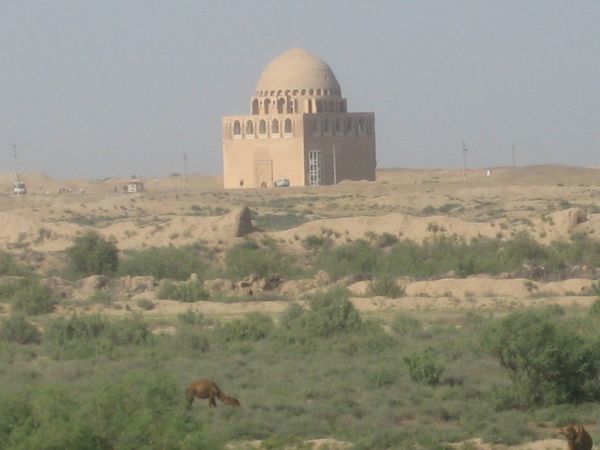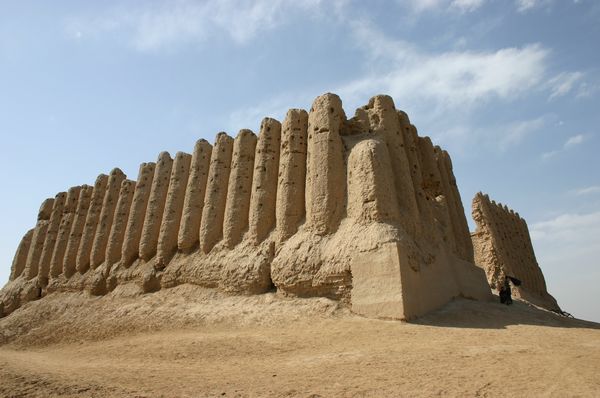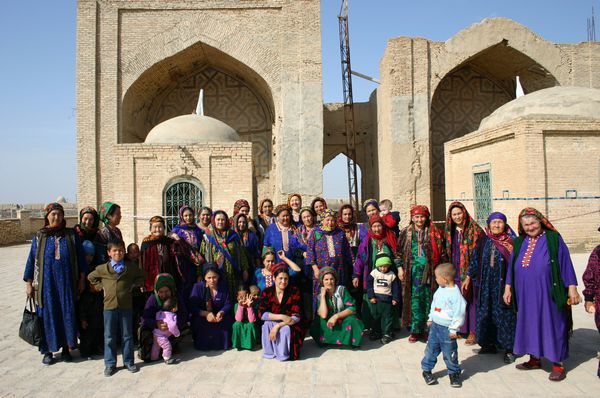Ancient Merv, Turkmenistan. One of the greatest cities in the history of the world.
Ancient Merv
Turkmenistan
Ancient Merv Introduction
History of Ancient Merv
What to do in Ancient Merv
How to get to Ancient Merv
Ancient Merv Introduction
Writing about Ancient Merv is a daunting prospect.
Simply put, it is one of the greatest cities in the history of the world.
Yet, it lies in ruins. With camels, sheep, and the occasional human roaming the vast area in which once stood a mighty multicultural metropolis.
It is both awe-inspiring and deeply sad.
An evocative place of intensely vibrant history. But one which needs concentration, appreciation, and focus on the details to bring to life today.
History of Ancient Merv
In the mid-12th Century, the golden age of the Silk Road, Merv was possibly the largest city in the world. It had a reported population of more than one million people.
Merv had grown in stages from a simple oasis in the 3rd Century BC to one of many Alexandrias. Merv was created by Alexander the Great as his Hellenic forces swept through the area after their epoch-defining defeat of the previously dominant Persians.
City after city was built on the site and merged into a vast conurbation.
As trade and communications developed over the centuries, the variety of people visiting, passing through, and settling in Merv expanded.
The city became possibly the first truly cosmopolitan place in the world.
An Ancient Metropolis
With a complex series of canals irrigating the whole area, it was a literal oasis as well as an intellectual, spiritual, and philosophical one.
Houses of worship and learning sat side by side.
8km of walls encircled the central citadel. Remnants of which still exist. Workshops producing goods in fine metals as well as industrial goods proliferated, and even ice could be found commercially produced in this desert. (Ruins of ice houses exist here still!).
Backgammon was invented in Merv.
Some claim even Chess has its origins here rather than in India.
Population in Merv
While the population by the peak of the city was predominantly Muslim, there were also Christians. Nestorian heretics and those of the more established variety. There were also Buddhists, Chinese, and even a population claimed to be descended from the defeated Roman Legion of Marcus Crassus. (He was memorably executed brutally and poetically by the Parthians centuries earlier).
Merv's Downfall
All things must pass though.
The passing of peak Merv came at the hands of Genghis Khan.
A siege in 1221 ended in utter destruction of the city and its population. A mere handful of survivors were made up of the most skilled artisans, taken away to pass on their skills to their new masters.
The Golden Age was over.
Merv would dwindle over the next centuries even though the remnants of the buildings provided shelter to thousands of people at any one time.
The death blow came with the deportation of the entire population of 1785 to the Bukhara Region, in today’s Uzbekistan.
Merv’s once-magnificent buildings again began to crumble into the sands.
It is hard not to stand in the ruins of Merv and be moved to come up with a knock-off version of Bryon’s poem Ozymandias. The depth of history erased here so long ago hangs heavy over the remnant.
And who knows how many more years of utter abandonment it would have taken for Merv to vanish from the human memory as well as the physical earth.
What to do in Ancient Merv
The site of Merv is vast.
You need a vehicle to get around. We recommend an entire day trip due to the wealth of ruins in existence and the distance between them.
There are all manner of mausolea, old wall remnants, and other archaeological features to visit on a trip here.
We don't have time to list them all. But we will add some highlights and you can see in much greater detail on the spot.
Visiting Ancient Merv
Erk-Kala
This is the fortress of one of the first of the cities that would merge in all three dimensions to become Merv. The city of Alexandria.
Walls that towered up to 30m high were built in the 3rd Century BC. Today they still exist - although mostly as mounds than true walls now.
Digs continue here as this area has the longest history and some of the most diligent teams of archaeologists working on it.
No buildings remain extent inside the walls. So it is a matter of extrapolation and imagination as to how much of a sense of life millennia ago you can get here.
Gyaur Kala
The successor city to Erk-Kala.
Gyaur Kala is a much larger complex that engulfed the former Alexandrian fortress. It spread itself out under the rule of first the Hellenistic successor Empires and then Islamic rule following the Arab conquest.
It's also a walled city. With barriers mightier than any other city in the world at the time. This is because they were made of mud bricks. It makes them fragile this far removed from their baking so a car should be taken when climbing up the embankments that have grown up over these walls.
Sultan Kala
The peak city of Merv existed within this city that in turn engulfed Gyaur-Kala.
Again we have walls. But this time also a moat and a more complex irrigation system. Water is indeed life in this region. More so than most other major cities of the time.
Many of the ceramic pipes have been excavated. However, hundreds of km of them remain undiscovered and beneath your feet.
This was a proper city that we would recognise now. With slums, administrative centres, and caravanserais (early hotels). All of them reduced to lumps in the landscape now.
However, with a good guide and a sensitivity to the ravages of time, you can still have your awe-inspired in this place!
Mausoleum of Sultan Sanjar
Finally, a real building. With a roof and everything!
This was reconstructed to repair the damage done by the unsympathetic Mongols.
This mausoleum is one of the most architecturally significant buildings of its era. It has a commanding height of 38m with shining turquoise tiles on a square double dome.
It was specifically designed to be seen from a day’s march away; to welcome home returning armies and the double dome technique is visible here in a complete form. Unlike the damaged version you can see in Konye-Urgench.
Inside it is cool and fresh regardless of the raging inferno of summer outside. Pilgrims still make journeys to visit this holy place, despite the lack of the remains of Sanjar himself, removed by the Mongols.
Sultan Sanjar
A note on Sultan Sanjar the man.
Sultan of the mighty Seljuk Turks, the preeminent power in the region for centuries.
He warred against his brothers to claim the throne, crushed rebellions on all sides, invaded and ravaged his neighbours, repelled invaders, and even went to battle with the famed Assassins.
In general, he was a tough guy and fought many other tough guys, winning and losing at times.
His final passing in 1157 marked the end of the Seljuk Empire as a viable civil and military force. It was only a few decades until the Mongols took control of the whole area.
Not only a man of war but also a patron of the arts. Sanjar is venerated mostly for his support of Persian poetry more than anything else these days.
Kyz Kala
Probably the most recognizable building in what remains of ancient Merv.
This highly impressive mudbrick structure has corrugated walls. It was in use for around 400 years. However - the Mongols ravaging the exact use of this large structure is still open to debate.
UNESCO, which inscribed the whole of the ancient Merv site in 1991, considers Kyz-Kala to be the best-preserved example of a köshk in existence.
It will be the site of most of your photos when you visit Merv too. A very beautiful structure even though half-destroyed.
It is a place you can start to truly imagine and appreciate the prosperity of Merv at its peak.
How to get to Ancient Merv
Merv is right in the middle of the country. And in the desert. So your choices are by road or by air to the nearby city of Mary.
Driving from Ashgabat takes around 5 hours on a decent road. Flights to Mary Airport take around an hour.
Did the Mongols leave any good hotels?
No, they didn’t.
There are no overnight options in the actual site of Merv apart from sleeping rough and camping. Which isn’t allowed (it is a UNESCO site after all).
The nearest accommodation overnight is in the city of Mary.
There are also no restaurants in Merv. The advanced irrigation system was destroyed 800 years ago, so take enough to eat and drink when visiting and touring the site.
Koryo Tours
Turkmenistan Tours
Turkmenistan Travel Guide | Sign up to the mailing list | About Koryo Tours


